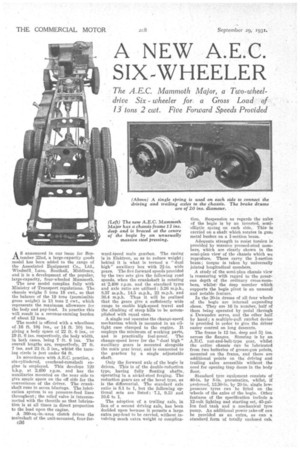A NEW A.E.C.
Page 58

If you've noticed an error in this article please click here to report it so we can fix it.
SIX-WHEELER
The A.E.C. Mammoth Major, a Two-wheeldrive Six wheeler for, a Gross Load of 13 tons 2 cwt. Five Forward Speeds Provided
AS announced in our issue for September 22nd, a large-capacity goods model has been added to the range of the Associated Equipment Co., Ltd., Windmill, Lane, Southall, Middlesex, and it is a development of the popular, large-capacity, four-wheeled Mammoth.
The new model complies fully with Ministry of Transport regulations. The chassis weighs 5 tons 118 cwt., so that the balance of the 19 tons (permissible gross weight) is 13 tons 2 cwt., which represents the maximum allowance for the body and pay-load. In practice this will result in a revenue-earning burden of about 12 tons.
The model is offered with a wheelbase of ,l6 ft. 10-i ins., or 14 ft. 10i ins., giving a body space of 22 ft. 6 ins., or 19 ft. 6 ins, respectively, the body width, in both cases, being 7 ft. 6 ins. The overall lengths are, respectively, 27 ft. 7 ins, and 23 ft. 5 ins., whilst the turning circle is just under 64 ft.
In accordance with A.E.C. practice, a six-eylindered, overhead-camshaft engine is employed. This develops 120 b.h.p. at 2,400 r.p.m. and has the auxiliaries mounted on the near side to give ample space on the off side for the convenience of the driver. The crankshaft runs in seven Marings. The lubrication system is on pressure-feed lines throughout ; the relief valve is interconnected with the throttle so that lubrication is at all times in direct proportion to the load upon the engine.
A 360-sq.-in.-area clutch drives the mainshaft of the unit-mounted, four-forc36 ward-'speed main gearbox. The easing is in Etektron, so as to reduce weight ; behind it is what is termed a " dual high" auxiliary box with 2ft-in. wide gears. The five forward speeds provided by the two sets give the following road speeds, when the crankshaft is rotating at'2,400 r.p.m. and the standard tyres and axle ratio are utilized: 5.26 m.p.h., 8.57 m.p.h., 14.5 m.p.h., 23 m.p.h. and 36.4 m.p.h. Thus it will be realized that the gears give a sufficiently wide range to enable high-speed travel and the climbing of steep hills to be accomplished with equal ease.
A single rod operates the change-speed mechanism which is mounted in an oiltight ease clamped to the engine. It employs the minimum of working parts, and is practically fool-proof. The change-speed lever for the " dual high" auxiliary gears is mounted alongside the main gear lever, and is connected to the gearbox by a single adjustable shaft.
Only the forward axle of the bogie is driven. This is of the double-reduction type, having fully floating shafts., operating in a nickel-steel forging. The reduction gears are of the bevel type, as is the differential. The standard axle ratio is 8.1 to 1, but the following optional sets are listed: 7.1, 9.33 and 10.6 to 1.
The adoption of a trailing axle, in lieu of a second driving axle, has been decided upon because it permits a large extra pay-load to be carried, without involving much extra weight or complica
tion. Suspension as regards the axles of the bogie is by an inverted, semielliptic spring an each side. This is carried on a shaft which rotates in gun, metal bushes op a I-section beam.
Adequate strength to resist torsion is provided by massive pressed-steel members, which are clearly shown in the semi-plan view of the chassis which we reproduce. These carry the I-section beam ; torque is taken by universally jointed longitudinal members.
A study of the semi-plan chassis view is reassuring with regard to the generous depth of the ordinary cross-members, whilst, the deep member which supports the bogie pivot is an unusual and notable feature.
In the 20-in drums of all four wheels of the bogie are internal expanding shoes. They are 16 in number, half of them being operated by pedal through Dewandre servo, and the other half by hand ; a multiple-pull ratchet device is provided in order to give the driver easier control on long descents.
The frame is 12 ins, deep and 3i ins. across the flanges. Steering is by an A.E.C. nut-and-bolt-type gear, whilst the entire chassis can be lubricated from two batteries of grease-gun points, mounted on the frame, and there are additional points on the driving and trailing axles accessible without the need for opening trap doors in the body floor.
Standard tyre equipment consists of 40-in. by 8-in, pneumatics, whilst, if preferred, 13.50-in. by 20-in, single lowpressure tyres can be fitted on the wheels of the axles of the bogie. Other features of the specification include ar 12-volt lighting and starting set,,45-gallon fuel tank and a mechanical tyre pump. An additional power take-off can be provided as an extra, as can a standard form of totally enclosed cab.












































































































